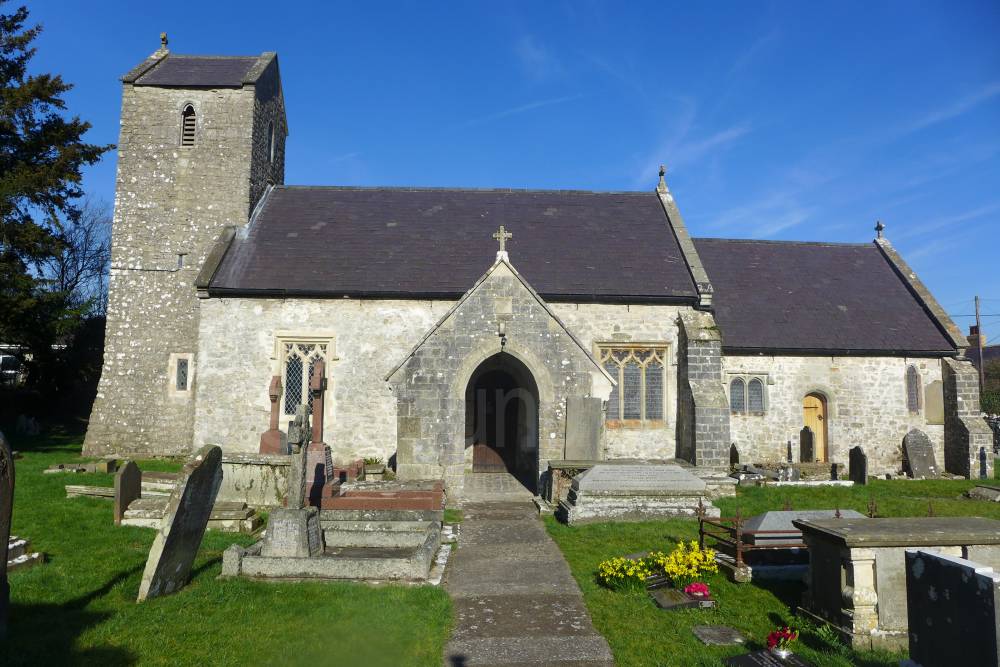- Cowbridge, Holy Cross
- Flemingston, St Michael & All Angels
- St John the Baptist, Llanblethian
- St Dochdwy, Llandough
- St Brynach, Llanfrynach
- St Canna, Llangan
- St Senwyr, Llansannor
- St John the Evangelist, Penllyn
- St Hilary, St Hilary
- St Mary, St Mary Church
- St Mary, St Mary Hill
- St Owain, Ystradowen
- St Tydfil, Llysworney
- Holy Trinity, Llandow
- St Michael and All Angels, Colwinston
Holy Trinity, Llandow

Sub Wardens
Mrs Andrea Walton
Miss Penny Newman
Sunday Service
2nd Sunday of the Month – 6pm Evening Prayer
4th Sunday of the Month – 11am Eucharist
Download the latest Pews News for details of services this week.
Possibly of pre-Conquest origin, this little church sits in the heart of the village.
The earliest fabric in the church dates from the Norman period. The building comprises nave, chancel, south porch, and a low saddleback west tower with one bell.
The C12th tub-shaped font of Sutton stone at the west end of the nave and the pillar piscine in the south-east corner of the sanctuary are both medieval survivals. The narrow chancel arch resting on pillars is probably early Norman, but above it is a wider, loftier arch presumed to be of later date. The area between the two arches is filled-in (forming a blind super arch) and the arch is flanked by large apertures or ‘squints’.
A few medieval features survive in the east end of the church. These include two rough corbels on the chancel arch denoting the existence of a former rood loft;
a priest’s door with a rounded arch, located in the south wall of the chancel between two windows; and the pillar piscina in the south-east corner of the sanctuary. Also,
secured against the north wall of the chancel, is a large stone fragment of a medieval (C14th) female effigy, much mutilated.
In the floor of the central aisle of the nave is a sepulchral slab with Calvary cross. Its inscription includes the name Edwardes and the date of his death 1587.
The chancel was restored in 1712 during the incumbency of Revd Richard Hancorne, rector, an event recorded in Latin by a stone tablet on the exterior south wall of the chancel.
Restoration of the church in 1889/90 is recorded in Latin on a tablet on the front of the porch.
Monuments in the church include those commemorating members of the Jones family of Llandow, the Bowen family of Colwinston and the Rees family of Sutton. Among them, on the south side of the chancel, is an early C19th black & white marble monument in classical style with a draped urn on a sarcophagus commemorating Mary Jones. Members of the Rees family are commemorated by a square stone tablet on the west face of the chancel arch.
A number of C17th/C18th tombstones, originally in the floor of the sanctuary, now rest against the east wall of the porch. One of these recorded the death of the Revd Richard Hancorne in 1732. Exposure to the elements has now all but destroyed the inscriptions and decorative details on these stones. Such as still remained were recorded by the Glamorgan Family History Society as part of their Monumental Inscriptions Survey in Glamorgan in 1993.
The base of a medieval cross with a broken octagonal shaft survives in the churchyard Prominent and distinctive among the monuments in the churchyard are those at the west end commemorating members of the Franklen familyof Clemenstone, among them Sir Thomas Mansel Franklen of Clemenstone and St Hilary, clerk of the peace for Glamorgan and clerk of the county council, whose photographs of Celtic crosses and historic buildings still provide a valuable resource for archaeologists and historians.